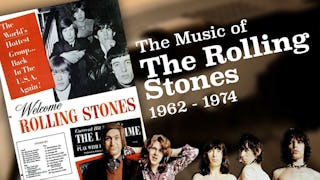This course, part 2 of a 2-course sequence, examines the history of rock, primarily as it unfolded in the United States, from the early 1970s to the early 1990s. This course covers the music of Led Zeppelin, the Allman Brothers, Carole King, Bob Marley, the Sex Pistols, Donna Summer, Michael Jackson, Madonna, Prince, Metallica, Run-DMC, and Nirvana, and many more artists, with an emphasis both on cultural context and on the music itself. We will also explore how developments in the music business and in technology helped shape the ways in which styles developed.



(467 reviews)
What you'll learn
Students will be able to summarize and describe how rock music progressed from the early 1970's through the early 1990's.
Details to know

Add to your LinkedIn profile
3 assignments
See how employees at top companies are mastering in-demand skills


Earn a career certificate
Add this credential to your LinkedIn profile, resume, or CV
Share it on social media and in your performance review

There are 7 modules in this course
What's included
1 video6 readings
A series of styles continue to develop the combinations of late-1960s psychedelia: blues-rock, southern rock, progressive rock, jazz-rock, theatrical rock, country rock, and singer-songwriters. Rock becomes increasingly ambitious. [Read Chapter 8 and work through listening guides for that chapter, viewing dedicated video.]
What's included
9 videos
Moving along a parallel but mostly separate path, black pop develops with the help of James Brown and Sly and the Family Stone. Motown continues, the rise of funk and Blaxploitation films. Bob Marley and reggae. The emergence of disco the reaction of rock fans. [Read Chapter 9 and work through listening guides for that chapter, viewing dedicated video.]
What's included
8 videos1 assignment
Rock style from the early 70s are streamlined and labeled corporate rock, as the music business expands even further. The mega-album. Punk reacts with a return to simplicity. New wave develops the punk attitude. [Read Chapter 10 and work through listening guides and dedicated video.]
What's included
9 videos
MTV emerges from a developing cable television industry. Michael Jackson and Thriller. The rise of Madonna, Prince, and Janet Jackson. Does MTV make music more visual than aural? Mainstream rockers continue thrive. [Read Chapter 11 and work through listening guides and dedicated video.]
What's included
8 videos1 assignment
Developing out of underground scenes of the late 1970s, heavy metal and hip hop become important mainstream styles in the late 1980s, aided by exposure on MTV. The rock reaction against rap. [Read Chapter 12 and work through listening guides and dedicated video.]
What's included
9 videos
The growth of "classic rock" and the development of the history-of-rock awareness. A survey of artists as they relate to earlier trends in the history of rock, including teen idols, hip-hop, 60s-influenced rock, female singer-songwriters, dance music, indie rock, and heavy metal. [Read Chapters 13 and 14 and work through listening guides and dedicated video.]
What's included
10 videos1 assignment
Instructor

Offered by
Explore more from Music and Art


University of Rochester


University of Florida


Vanderbilt University


University of Rochester
Why people choose Coursera for their career




Learner reviews
467 reviews
- 5 stars
84.15%
- 4 stars
13.49%
- 3 stars
1.71%
- 2 stars
0.21%
- 1 star
0.42%
Showing 3 of 467
Reviewed on Jun 1, 2020
This was a fun course and motivates to seek out Part One of the History of Rock. The instructor did a great job to take us on this historical journey.
Reviewed on Oct 6, 2015
Very interesting information. I lived through a lot of this material so it was doubly interesting. Very thorough, unbiased and informative.
Reviewed on Sep 23, 2017
Excelent. Actually now is more fun to read about musicans (recently Iggy Pop & Black Sabbath) because context is better understood. (A bit weird that Tom Waits is not even mentioned)

Open new doors with Coursera Plus
Unlimited access to 10,000+ world-class courses, hands-on projects, and job-ready certificate programs - all included in your subscription
Advance your career with an online degree
Earn a degree from world-class universities - 100% online
Join over 3,400 global companies that choose Coursera for Business
Upskill your employees to excel in the digital economy
Frequently asked questions
Access to lectures and assignments depends on your type of enrollment. If you take a course in audit mode, you will be able to see most course materials for free. To access graded assignments and to earn a Certificate, you will need to purchase the Certificate experience, during or after your audit. If you don't see the audit option:
The course may not offer an audit option. You can try a Free Trial instead, or apply for Financial Aid.
The course may offer 'Full Course, No Certificate' instead. This option lets you see all course materials, submit required assessments, and get a final grade. This also means that you will not be able to purchase a Certificate experience.
When you purchase a Certificate you get access to all course materials, including graded assignments. Upon completing the course, your electronic Certificate will be added to your Accomplishments page - from there, you can print your Certificate or add it to your LinkedIn profile. If you only want to read and view the course content, you can audit the course for free.
You will be eligible for a full refund until two weeks after your payment date, or (for courses that have just launched) until two weeks after the first session of the course begins, whichever is later. You cannot receive a refund once you’ve earned a Course Certificate, even if you complete the course within the two-week refund period. See our full refund policy.
More questions
Financial aid available,


